七年级英语Module7Unit1 课件
牛津译林英语 七年级上册Unit7Reading 1 Going shopping-课件
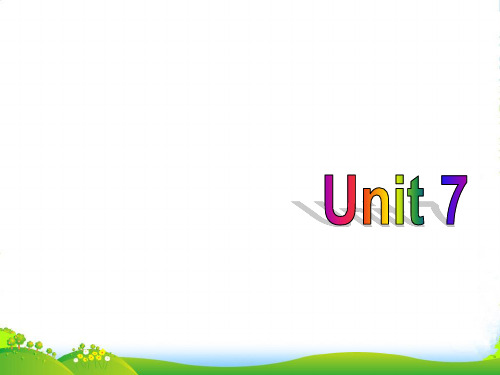
It is not cheap in China. cheap adj. 便宜的
last adj. & adv. last year 最近刚过去(的);最后 (的)
a nice hair clip hair clip 发卡,发夹
The sweater matches the trousers well.
1. Amy want to buy Simon _c____.
a
b
c
2. This year’s football cards cost _b__ each.
a
b
c
3. Amy takes _c_ as Sandy’s present.
a
b
4. The hair clips cost __b__.
Amy bu__y_s five. In the second shop, she finds nice ha_i_r_c_li_p_s. She thinks they m_a_tc_h__ Sandy’s p_in_k_ coat. All the gifts cost Amy ni_n_e_t_ee_n__ yuan.
The presents __c_o_st__ Amy 19 yuan. The presents I want to buy for Simon and Sandy are 23 yuan. I have _en__o_u_g_h money for them.
Retell the passage.
last adj. & adv. 最近刚过去(的); 最后(的)
hair clip n. 发卡,发夹 match v. 与…相配,般配 pink adj. & n. 粉红色(的) pretty adj. 漂亮的,俊俏的 enough adj. adv. pron. 足够,充分 change n. 零头 different from 与……不同
最新外研社七年级英语Module7 Unit1说课稿

Unit 1 I was born in a small village说课稿一. 教材分析本模块的主要语法是含有动词be的过去式(was / were)的一般过去时,教学重点是通过对过去生活和经历的描述,重点学习本模块中出现的重点词汇、短语、固定搭配和句型。
本单元是外研版英语七年级( 下 )第七模块第一单元。
主要围绕小时候及小学的事情这一主题展开各种教学活动,学习be动词一般过去式的表达。
在今后的英语学习中都占重要的地位。
本单元的学习目标:1.语言知识目标:掌握下列单词: born, strict, primary, primacy school, town, friendly, US, hey, village, nice, good, difficult2. 语言技能目标:1)能听懂包含动词be的过去式(was / were)的对话。
2)能用动词be的过去式(was / were)表述自己过去的经历,并能用它询问对方过去的生活。
3)能够读懂描述过去生活和经历的短文,并能就短文作答。
4)能用动词be的过去式(was / were)描述自己和别人的过去生活和经历。
3. 情感目标:通过对过去童年或家乡的描述,产生对家乡和美好生活的热爱。
二.教学方法课前准备一些与本模块话题相关的图片和资料,让学生在warming-up时讨论和观看。
围绕本模块话题展开听说读写的全面训练,使学生熟悉含有动词be的过去式(was / were)的一般过去时。
以说为主要教学方式,以讨论为主要方法,通过同桌讨论和小组以及全班讨论,让每个学生充分练习口语和说的能力,并将听说读写有机地贯穿一体。
设立一些语言环境,结合自己或他人的过去生活和经历,最后一起学习本模块的重、难点,为突破重、难点再做一些课堂和课后的练习。
三.教学过程Unit 1 I was born in a small village.Step1:Greetings and Listening the song”Yesterday once more”.Step2:New words and Warming up用学生感兴趣和熟悉的一些人激发他们对be born 句型的学习,并谈论他们自己的出生地和出生时间。
外研版七年级英语上册ModuleUnit教学课件
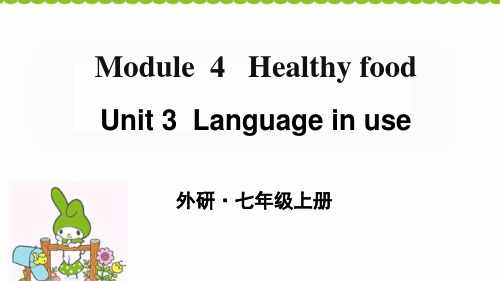
外研版七年级英语上册课件ModuleUni t
some的用法:some意为“一些”,可作形
容词和代词。它常修饰可数名词复数。
如:some books 一些书 some boys 一些男孩
some 常用 在肯定句中。
也可修饰不可数名词:
some water 一些水 some tea 一些茶叶
外研版七年级英语上册课件ModuleUni t
外研版七年级英语上册课件ModuleUni t
A Western breakfast
In the West, for breakfast, people usually eat bread and eggs and drink coffee or tea, milk and fruit juice.
➢ 以s, x, ch,sh结尾的名词后加-es box boxes 盒子 watch watches 手表
外研版七年级英语上册课件ModuleUni t
➢ 以f 或fe 结尾的名词,多数变f 或fe 为v 再加-es leaf leaves 树叶 knife knives 小刀
➢ 以“辅音字母+-y”结尾的名词,变 y为 i再加-es party parties 聚会 story stories 故事
外研版七年级英语上册课件ModuleUni t
外研版七年级英语上册课件ModuleUni t
但在表示建议,反问,请求的疑问句中,或 期望得到肯定回答时,多用some而不用any。 如:Would you like some coffee?
你要不要来点咖啡? How about some fruit juice? 来点水果汁如何?
Module7MypastlifeUnit1第1课时教案2023-2024学年人教版七年级英语下册

Module7My pas tlifeUnit1第1课时教案2023-2024学年人教版七年级英语下册一、教材分析本课为人教版七年级英语下册Module 7 "My Past Life" Unit 1,主要内容包括介绍过去的生活和谈论过去的事情。
本课时将学习一般过去时态的构成和用法,以及如何用一般过去时态描述过去的事情。
通过本课的学习,学生能够掌握一般过去时态的构成,能够运用一般过去时态描述自己的过去经历。
教学过程中,我将引导学生通过观察、听、说、读、写等多种方式,感知、理解和运用语言知识,提高他们的语言运用能力。
同时,我将注重培养学生的学习兴趣和积极性,鼓励他们主动参与课堂活动,提高他们的合作意识和团队精神。
二、核心素养目标本课旨在培养学生的英语学科核心素养,包括语言能力、文化意识、思维品质和学习能力。
通过本课的学习,学生将能够运用一般过去时态描述自己的过去经历,提高他们的语言运用能力。
同时,学生将了解和感受西方的文化背景,增强他们的文化意识。
通过听力、口语、阅读和写作等多种活动,学生将锻炼和提升他们的思维品质,如观察、分析、判断和推理等。
在自主、合作和探究的学习过程中,学生将培养和提高他们的学习能力,如自主学习、合作学习和探究学习等。
三、学习者分析1. 学生已经掌握了哪些相关知识:在开始本课之前,学生应该已经掌握了简单的英语语法知识,如现在时态,以及一定程度的词汇量。
此外,学生应该具备基本的听、说、读、写技能,能够进行简单的日常交流。
2. 学生的学习兴趣、能力和学习风格:七年级的学生对新鲜事物充满好奇,对英语学习有一定的兴趣。
在学习能力方面,学生具备一定的逻辑思维和语言表达能力。
在学习风格上,他们习惯于通过听讲和模仿来学习,同时也需要一定的互动和合作机会来激发学习动力。
3. 学生可能遇到的困难和挑战:在本课的学习中,学生可能会对一般过去时态的构成和用法感到困惑,特别是在实际运用中,如何正确使用一般过去时描述过去的事件。
外研版七年级英语上册教案 Module7 Unit1

两人展示,互评
给出相应的图片及提示词
3.读前听(对应目标1、2)
一层听
1.Listen andchoose the correct answer.
What does Lingling want to do?
A. write her homework on the computer
V.connect click print share check plan search send customer Internet document Australia
(3)障碍点
正确运用特殊疑问句型进行表达是难点。
(4)个性化目标
有的学生对于行为动词的一般现在时不能熟练应用。优生能够灵活运用所学句型,差生能够对课文中重点句型熟记。
学情
分析
1.知识经验
(1)已有知识经验
经过之前的学习,学生已经会读写一些单词,例如:n.train travel music movie night email game cinema clothes holiday
v.turn use visitlearnadv.sometimes
(2)未学知识
词汇:n.keyboard mouse screen document paper company ticket information
Finally, click “print” and “OK”.
突破措施:创设情境,利用我们使用的电脑让学生进行对话形式进行实践的练习。
难点:how, where引导的一般现在时的特殊疑问句。
突破措施:讲解固定句型,熟记的前提下进行对话与书写的练习正确使用There be句型来表达教室内存在的设施及两位数数词构成方式。
外研版英语七年级下册《module 7 unit 1 I was born in a small v

外研版英语七年级下册《module 7 unit 1 I was born in a small village》教学设计一. 教材分析外研版英语七年级下册《Module 7 Unit 1 I was born in a small village》是一篇关于个人成长和家庭背景的阅读文章。
通过讲述一个人的成长经历和家庭成员的信息,让学生了解和掌握一般过去时态、描述人的外貌和性格的词汇和句型。
本节课主要通过阅读理解,提高学生的阅读能力,同时培养学生的语言运用和表达能力。
二. 学情分析七年级的学生已经掌握了基本的英语语法和词汇,对于描述人和事物的词汇和句型有一定的了解。
但部分学生对于一般过去时态的运用还不够熟练,需要老师在课堂上进行重点讲解和操练。
此外,学生在阅读理解方面还需要进一步提高。
三. 教学目标1.知识目标:–能正确运用一般过去时态描述过去的事情。
–掌握描述人的外貌和性格的词汇和句型。
–提高阅读理解能力。
2.能力目标:–能用英语进行简单的交流,表达自己的观点和感受。
–能够独立完成阅读理解题目。
3.情感目标:–培养学生对家庭和成长的认知,增强对生活的热爱。
–提高学生的团队合作意识和沟通能力。
四. 教学重难点•一般过去时态的运用。
•描述人的外貌和性格的词汇和句型。
•阅读理解能力的提高。
•一般过去时态的运用,特别是动词过去式的构成。
•复杂句型的理解和运用。
五. 教学方法1.情境教学法:通过设定情境,让学生在实际语境中学习和运用英语。
2.任务型教学法:通过完成任务,提高学生的阅读理解和语言运用能力。
3.小组合作学习:培养学生的团队合作意识和沟通能力。
六. 教学准备1.教师准备:–提前准备好教学PPT,包括教材内容、例句、练习题等。
–准备相关的人物图片和视频,用于教学展示。
2.学生准备:–预习本节课的内容,了解一般过去时态的用法。
–复习描述人的外貌和性格的词汇和句型。
七. 教学过程1.导入(5分钟)–教师通过提问方式引导学生回顾一般过去时态的用法。
人教版高中英语选修七Module7Unit1Thefourthperiod-Listeningandspeaking

Barry:Ofthe15sightedclimbers,only7madeit.
Joan:Oh,___w_e_l_ld_o_n_e____!
Barry:Yes,itjustshowsyou _______h_o_w__d_e_te_r_m__in_e_d_t_h_e_b_li_n_d_c_li_m_b_e_r…swere.
2.Inwhatwayscansightedclimbershelpthem? Thesightedpeoplecanactastheireyes,telling themtherightdirection.
Tickthestatementthataretrue. ()T1.Barryisblind. ()F2.Barryisbetween25-45yearsold. ()T3.Theblindclimbersgotassistancefromsighted companions. ()F4.Moreofthesightedgroupreachedthetopof themountainthanthosewhowereblindor weak-sighted. ()F5.NextyearBarryisgoingtoclimbMount Qomolangma.
enoughto…,too…to
3.Thelittleboyisnottall____e_n_o_u_g_hrteoachthe apple. 4.Weare___to_o__willing___t_ohelpthedisabled. 5.Hedidn’trunfast___e_n_o_u_g_h_teoscapebeing buriedbythelava.
Joan:Well,Barry.I’mfullofadmirationforyouandyourc ompanions.Youhaveachievedsomethingquiteremar kable.
外研版七年级英语上册同步习题课件:Module 7 Computers Unit1

课堂导学
行为动词一般现在时的特殊疑问句的构成:特 殊疑问词+ do / does +主语+谓语动词原形+其 他?如: When do we have English? 我们什么时候上英语课? What does he often do after school? 他放学后经常做什么?
课堂导学
(7)__H_o_w__d_o__y_o_u_s_e_n_d__e_m__a_il_s_ on the computer? 你如何在电脑上发送邮件? (8)__W_h_e_r_e__d_o_e_s_h_e__w_o_r_k________? 他在哪里工作?
目录 contents
课文理解
课文理解
一、听对话。 听Unit 1 Act.1对话,回答第1~3小题。对话听两 遍。 ( B) 1. Who is asking for help? A. Tony. B. Ms Li. C. Daming.
课文理解
( C ) 2. What’s the last step(步骤)to make the computer work? A. Connect the screen to the computer. B. Connect the keyboard and the mouse to the computer. C. Turn on the computer.
(6)May I get __C___?
A. a paper
B. some papers
C. some paper D. any papers
课堂导学
7. How do I write my homework on the computer?我如何在电脑上写作业? ◆特殊疑问词有:how(怎样),what(什么), when(什么时候),where(在哪里), why(为什么),which(哪一个)
内蒙古鄂尔多斯市康巴什新区第二外研版七年级英语下册Module7Unit1课件 (共11张PPT)
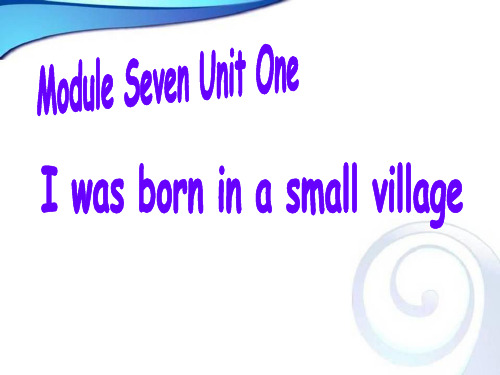
• • • • •
•
•
1.我出生于内蒙古的一个小村庄。 was ______ born in a small ________ village in I ______ Innnermongolia. 2. 你的第一所学校叫什么名字? was name of What _______ the _________ _______your first school? 3她的弟弟在第三小学学习。 primary Her brother is studying No.3________ _________. school 4. 他在班上很难管。 difficult _______ in class He is very _______ _______. 5. 你的第一所学校怎么样? What _______ is _______ your first school like ________?
was/were
were very happy when they won(赢 • (1) They _______ 得) the match. was • (2) He ______very angry when he heard(听到) the news. Was • (3) ______she naughty(淘气的) when she Was _______a child. was she • Yes, ______ _______. • (4) _______ Were they excited( 激动的)we saw( 看见) the famous star? Weren’t they _______. • No, ______ weren’t at home this (5). Betty’s parents _______ morning. (be not) wasn’ta lot of water in this river ten • (6) There ______ years ago. (be not)
浙江专用外研版七年级英语下册教学课件:Module 7Unit 1 I was born in a small village(共25张PPT)

4.三年前他住在一个小村庄里。 a small He lived _________ _________ _________ in village 3 years ago. _________ 5.你们村的名字是什么? is/was _________ name the What _________ _________ _________ _________ your village? of
二、完成句子,每空一词。 1.我记忆中的父亲不苟言笑,对我严格要求。 In my memory,my father was a man of few words was _________ strict _________ and he _________ with me _________. 2.昨天迈克在学校表现好吗? good at school yesterday? _________ Mike _________ Was 3.你的哥哥什么性格? What _________ is/was your brother _________? like _________
C Liu Li:2._________ A Diana:Zhaozhuang.3._________ Liu Li:I was born in Jiangsu Province. E Diana:4._________ Liu Li:It was Zhonghua Primary School.Who was your first teacher? Diana:My first teacher is Mr Wang. D Liu Li:5._________ Diana:He was very strict.But we were good friends.
七年级英语上Module7ComputersUnit1HowdoIwritemyhomework

A. to
B. at
C. on
D. in
13. Don’t ___A__ the TV. My baby is sleeping now.
A. turn on
B. turn off
C. look at
D. pick up
14. Do you know ___B__ to start the computer?
“play” to listen to music.
8. Alice uses the keyboard (键盘)to write her homework on the computer.
9. Sorry, I can’t see the words on the screen (屏幕). 10. John thinks it’s a little difficult to learn (学习)
四、根据汉语意思完成句子。 26. 你能教我如何打印这个文件吗? Can you teach me how to ______p_r_in_t_______th__e
_d_o_c_u_m__e_n_t ?
27. 我需要三张纸写信。 I need ______t_h_re_e____p_i_ec_e_s______o_f _____p_a_p_etro write a
goes home.
5. They go to the shop to buy some paper (纸). 6. [ 安徽合肥市瑶海区期末] You can use it to print .
(打印) your homework. 7. [ 安徽合肥包河区期末] You can click (点击)
24. He is a famous player and he __is_g_o_o_d__a_t_ playing basketball.
人教版七年级英语上册Unit7-第一课时教学课件
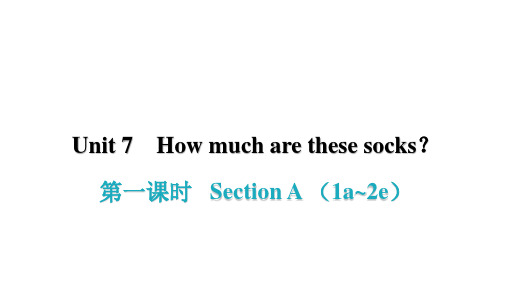
look的用法
1.look作连系动词时,意为“看起来;看上去”,后 接形容词作表语。如: He looks happy today. 他今天看起来很高兴。 This dress looks nice on you. 这条连衣裙穿在你身上 真好看。 2.look作实义动词时,意为“看”,可单独使用。如 果要接宾语,需与介词at连用。如: Look!The bus is coming. 看!公共汽车来了。 Please look at the blackboard. 请看黑板。
( B )1. She looks _______ her mother and smiles.
A. with
B. at
C. on
2. The cake looks so ___g_o_o_d___ (good / well). I like it.
for的用法
介词for用来表示物品价格时,意为“达;计”。常见 结构为:“价格+for+物品”或“物品+for+价格”。如: It's 15 yuan for this toy.这个玩具15元。 We have skirts for only 20 yuan.我们有仅卖20元的裙子。
A. Can I help you
B. What's your favorite drink
C. What would you like
( C )15. Ninety _______ is too much.I can buy a cheaper one online.
A. Yuan
B.yuans
二、根据汉语意思完成句子,每空一词 6.——那条短裤多少钱? ——25美元。 —___H__o_w__ __m__u_c_h__ _a_r_e_____ ___t_h_o_s_e_ shorts? —__T_h_e_y___ __a_re_____ 25 dollars. 7.那位男子的裤子是什么颜色的? __W__h_a_t__ __c_o_lo_r___ __a_r_e____ __t_h_e____ man's trousers?
Module7 unit1
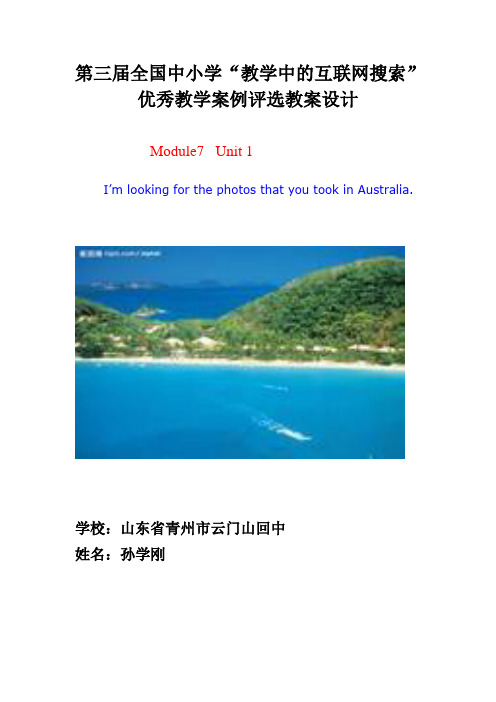
1. Read the dialogue frequently and remember the words.
2. Finish the exercises in the workbook.
3. Make a poster about the country that you like best.
2.Have Ss work in pairs.Talk about different interesting things in Australia.
For example:
Where is Australia? What / Who did you see there? …
These words and phrases may help you:
山东省青州市云门山回民初级中学
262500
自我介绍:本人从教十几年以来,在工作中勤奋学习,刻苦钻研,勤勤恳恳,任劳任怨,勇于探索,努力走科研兴教之路。
五、教学反思:
通过对课文的学习,让学生谈论自己的真实的经历或者希望游览的地区,介绍自己感兴趣的景点或当地的旅游资源,激发学生学习英语的兴趣,提高他们学说英语的能力。
六、教师情况
省份
山东省
学校
山东省青州市云门山回民初级中学
姓名
孙学刚
职称
一级教师
电话
3819007
电子邮箱
Sxg3758@
通讯地址
2.Ask Ss to find out all the attributive clauses in the dialogue.
3. Check the answers.
Step 5 Pair work: Do you know Australia?
Module7 Travel Unit1

山东省潍坊市青州市谭坊镇南魏小学
王文红
目 录
1. warm up 2 new words 3 Questions. 4 text 5 exercise 6 Guess Daming Lingling 7 make a plan 8practice to say 9 summary
9 summary text
exercise
目 录
1. warm up 2 New words 3 Questions. 4 text 5 exercise 6 Guess Daming Lingling 7 make a plan 8practice to say
9 summary act
目 录
中国名胜相册
I'm from China.
by plane
乘飞机
Lingling
7 make a plan 8practice to say
I’m going to go by plane. We’re going to go …
visit
拜访 看望
visit my grandpa
9 summary
Daming Lingling
New words and expressions
目 录
China
1. warm up 2 New words 3 Questions. 4 text 5 exercise 6 Guess Daming
from
来自
点击打开
tomorrow
明天
We’re going to go to Hainan tomorrow.
新疆 火车
台湾 轮船 by ship 照相 北京 飞机 参观天安门
外研版英语课件七上Module7 unit 1

How do you save the document?
Homework:
1. Act out the conversation. 2. Draw a poster about what you can do on the computer. 3. Record(录制) a piece of video about the story of you and your computer , and send it to me.
Ⅳ. How do you write your
homework on the computer?
First,
Next, Then,
Finally,…
Ⅴ. What have we learned today?
Preview show 预习展示
Words and expressions
Parts of the computer
[ 'ki:bɔ:d ] We use it to type. [taɪp]打字ts of the computer
screen
[ skri:n ] skirt We use it to show pictures and words.
Learning new words
First, connect the screen to the
computer. Next, connect the keyboard and the mouse to thecomputer. Finally, turn on the computer.
Open the computer. ______
Group one
Group two
Group three Group four Group five Group six
新目标七年级英语上册Unit7Section A 1教学课件

How much is/are …?
It’s… / They’re…
2a Listen and repeat.
black white
red
green blue yellow brown purple
big
small
short long
Look at the pictures and fill in the blanks.
Conversation 5 -- I like those long b__lu_e_ and _y_e_ll_o_w_
socks. How much _a_r_e_ _t_h_e_y_? -- _T_h_e_y_’_re_ only _t_w_o_ dollars. Conversation 6 -- How much are the black trousers? -- They’re __n_in_e_ dollars.
a pair of trousers/ shorts two pairs of soccer shoes
5. It looks nice. 与That sounds good. 属同一结构,look表 示“看起来,看上去”, 后接形容词。如: 那个人看上去年长,但他没那么大年龄。
That man _lo_o_k_s_ old, but he’s not that old. 这双鞋穿你脚上真好看。
The shoes _lo_o_k_ nice on you.
1. 常见购物用语。 您要买点什么吗? Can I help you? 是的。 Yes, please. (……)多少钱? How much (is/ are…)? 我买了。 I’ll take it. 我买两双。I’ll take two pairs. 给您。(您拿好了。) Here you are.
- 1、下载文档前请自行甄别文档内容的完整性,平台不提供额外的编辑、内容补充、找答案等附加服务。
- 2、"仅部分预览"的文档,不可在线预览部分如存在完整性等问题,可反馈申请退款(可完整预览的文档不适用该条件!)。
- 3、如文档侵犯您的权益,请联系客服反馈,我们会尽快为您处理(人工客服工作时间:9:00-18:30)。
费俊龙 Jiangsu
聂海胜 Hubei
Shenzhou VI 2005.10
翟志刚 刘伯明 Heilongjiang Shanxi 2008.9 ShenzhouVII
景海鹏 Shanxi
景海鹏 刘旺 刘洋 2012.6 Shenzhou IX famous proud
2012,6 Shenzhou IX first woman Henan became pilot became taikonaut spent 13 days famous
Module 7 Unit 1 Shenzhou V flew into space.
fly flew is flying 飞 become became is becoming 成为 spend spent is spending 度过 hour hour an hour 小时 son 儿子 proud 自豪的,骄傲的 pilot 飞行员 taikonaut 中国宇航员
flying The bird is _______.
became a big bird. The small bird _______
There are four birds, and one was shot(射击),how many birds are left(剩下)? A. 1 B. 2 C. 3 D.4 E.0
You are your parents' sun.
proud: I'm proud. I'm proud of my school. ……
pilot: pi + lot taikonaut: taikong + astronaut
astronaut cosmonaut taikonaut
神五上天后,BBC、NYtime等知名媒 体均使用了taikonaut这一单词,它体现 了中国航天事业的巨大进步。
中国的 taikonaut 知多少
2003.10.15 ShenzhouV 杨利伟
中国的 taikonaut 知多少
2005.10.12 Shenzhou VI 费俊龙 聂海胜
中国的 taikonaut 知多少 2008.9.25 Shenzhou VII 翟志刚 刘伯明 景海鹏
中国的 taikonaut IX 刘旺
刘洋
1. When did Shenzhou V fly into space with Yang Liwei? In October 2003.
2. Where is Yang Liwei from?
Liaoning.
根据录音填空 Yang Liwei ____ about twentyone hours in space. He ____ a video about his space travel. Lots of people ___ it and now he ___ very, very famous. Yang Liwei's ____ was eight years old. He ____ his father in space and he was very _____ of him.
( )5. Draw and colour the Chinese flag.
( )6. Put the flag on your spaceship.
根据录音填空 In October 2003, Shenzhou V _____ into space with Yang Liwei. He ___ China's first man in space. Yang Liwei ___ from Liaoning. First he _____ a _____. Then he _____ a ______.
Why? Because the birds ______ flew away.
our hour: 同音词______ an hour 一个小时________ 度过一个小时_______________ spend an hour spend 21 hours 度过21个小时_______________ sun son: 同音词______ sun My son is my _____.
proud
2013.6--8 Shenzhou X 想象图
Today we are proud of China.
Tomorrow China will be proud of us.
( )1. Rollthe paper. Then stick it together. ( )2. Cut out the top. ( )3. Stick the top together. Then put it on. ( )4. Make the wings. Then stick them on.
